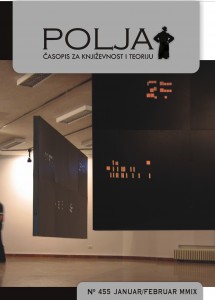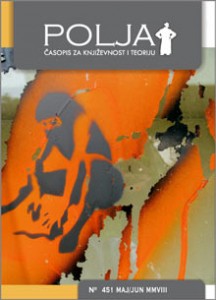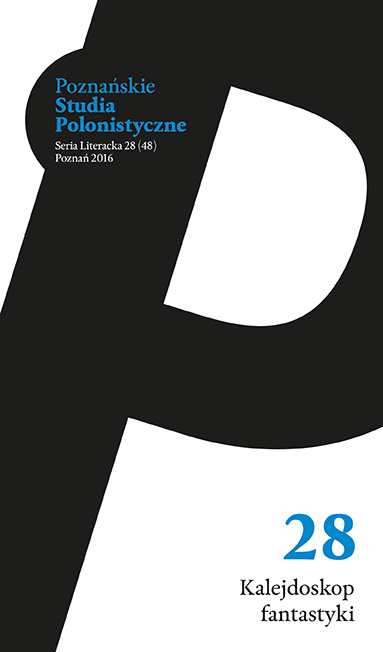
Verujem u vrednost umetnosti(Razgovor s Ješom Denegrijem)
Interview of Ješa Denegri by Sombati Balint
More...We kindly inform you that, as long as the subject affiliation of our 300.000+ articles is in progress, you might get unsufficient or no results on your third level or second level search. In this case, please broaden your search criteria.

Interview of Ješa Denegri by Sombati Balint
More...
The author concentrates on two points. In the first, the aesthetic function is defined as the main function of art providing a particular type of experience like the one when a work of art is transmitted to a qualified receiver. In the second, the aesthetic features and values are defined as relevant factors in each work of art, being a result of creative skills of artists who know to handle a media typical for a certain kind of art. However, these values are discovered and materialized only in the aesthetic experience of the receiver. The aesthetic values of art which are essential for art are thus closely connected to aesthetic experience.
More...
16. maj 1972. “Vruć kupac”. Već nekoliko dana sam pred teško rešivim pitanjem: kako izaći i sa čim? Najviše me muči pitanje političkog u umetničkom. Ne mogu da nađem alibi kojim bi se političko izbacilo iz mog delovanja. Želim da javno protestujem protiv procesa i presuda četvorici novosadskih pisaca. Ali, svi ćute i bojim se da odlučim sam, jer sâm ne mogu ništa da učinim da se stvari promene. Meni je stalo do toga da se stvari menjaju. Danas još ne znam šta da učinim.
More...
Iznoseći u svom eseju „Avangarda i kič“ iz 1939. upozoravajuću i sugestivnu konstataciju da „budući da avangarda oblikuje jedinu živu kulturu koju sada imamo, načelni opstanak kulture je ugrožen“,1 Grinberg nije lamentirao zbog iščezavanja klasičnih umetničkih formi. Prema njegovom uverenju, za krizu kulture nije odgovorna avangarda. Naprotiv, ona je jedina održava u životu, a kao razlog njene ugroženosti navedena je nesigurnost avangardnih vedeta u pogledu bogate i kultivisane publike od koje finansijski zavisi opstanak njihovih projekata.
More...
Gde treba tražiti najdublje razloge koji čine da ljudi jedan prema drugom osećaju simpatiju ili antipatiju, da mogu ili ne mogu biti prijatelji? Klarisa i Valter iz Čoveka bez svojstava su Ulrihovi stari poznanici. Prvi put se pojavljuju na sceni romana onda kada ih Ulrih poseti i zatekne ih kako sviraju klavir u četiri ruke. „Taj demon na kratkim nogama sa širokom gubicom, nastao ukrštanjem jazavičara i buldoga“, taj odurni „megafon, kojim duša baca u lice svekolikog mira svoj krik, kao jelen koji riče“, klavir je za Ulriha otelotvorenje svega što ne voli.
More...


The phrase used in the title of the article does not raise any doubts today, and may even seem trivial to the point that it can be used as an advertising slogan. With a more careful approach, it calls to mind the emphasis on the need link the aesthetic with everyday life, with keeping art up to date with the changes taking place in different non-artistic areas, etc. However, the author points out that in the Antiquity, the Middle Ages, and modern times, such proclamation would be considered an expression of the ignorance as to what real beauty is, or focusing only on its most external symptoms. He cites Plato, who wrote about the climbing towards true beauty, or Plotinus, who claimed that it only “lends itself” to well-formed things. In turn, regarding to the position of this notion among other categories taken into account in modern art, he notes that its meaning was often extended, this time horizontally, to stress the autonomy of the aesthetic values. Avant-garde artists deemed beauty irrelevant, saw it in a supplementary function, or radically modified its understanding (for example the “convulsive beauty” of the Surrealists). Summing up its situation, Władysław Tatarkiewicz wrote in 1970 that it was “in decline.” This conclusion, however, was not fully justified. Its author did not take into account the pragmatic concept of art proposed by John Dewey, which contributed to the American aesthetic thought of the last decades of the twentieth century, as reflected for example in the views of Richard Shusterman. This tendency, involving the blurring of lines between the values of elite and popular culture, can be regarded as an expression of specifically conceived democratization of beauty. Beauty, however, has been usually associated with uniqueness. An attempt to combine the democratic characters of beauty with its uniqueness is what camp can be considered to be.
More...
The purpose of this article is to answer the question ‘what is aesthetc theory?’ I try to perform the way of reasoning about this topic by Theodor Adorno. Such a challenge by definition must be spontaneous, and fully loaded with idiosyncratic volatilities and factors, while being fully aware that it is impossible to perform the mode of thinking of the great Frankfurt School figure. There is no way to repeat his negative dialectics skilled argumentation, one that undermines itself and therefore it is a seductive, probably the most proximate thinking about art. It is also incomprehensible comprehensibility that is usually the most attractive feature of art to us. Its unknowable truth. I begin with reminding the modern idea for aesthetics as a place of refuge from increasing rationalization of the world. Then I write about antinomy of art and paradox of theory – the sources and mechanisms of its cognitive emptiness. The next step is about philosophy of picture – its short history associated with Adorno’s concept of picture as a ‘field of forces’. In the end of searching for a way out from the antinomical trap I defend the thesis about aesthetic theory as a performance.
More...
The purpose of the article is to extract – taking Merleau-Ponty’s idea as an example – the movement of emerging of the world (becoming of the world a phenomenon) as deeply linguistic and at the same time bound to the basis oriented structures of our existence; to show how deeply this movement of phenomenalization is connected with perceiving the world ‘as’, that is with its interpretation incorporated in our fundamental perceptive experience. Eventually – what’s most important for the aesthetic conclusion of this text – to what extent structuration of the basis oriented experience penetrates artistic articulations.
More...
The main objective of the paper is to investigate how reflection on the ‘nature of recollection’ may change under the influence of transformations in understanding moder-nity. The analysis covers the esthetic dimension of the recollection process. Recollection has gradually solidified its position: from comprehensive conceptualizations of human temporality to various analyses of time experience, resulting in distinguishing memory as a separate issue, and finally to detailed considerations of its forms. The current trends in research are set, on the one hand, by new historiography and memory studies, and, on the other hand, by reflection on perception and body memory. In either case the esthetic aspect of recollection (memories) can clearly be observed. The esthetic is connected with either the ‘poetic’ (in the creative sense) aspect of the processes of recollection understood as a process of narrative building or aisthetic reconstruction by body memory.
More...
Archaic texts and artifacts shows that human appearance, physiognomy, figure, charm, motoric, and body functioning was perceived as ‘significant’ in peculiar contexts. They are worth recalling. Among others, biometric identification and mantic were practiced in ancient Mediterranean cultures. In the Middle Ages, human body became meaningful when celebrating in isolation from its everyday functionalities. Its ‘glory’ only appeared in light of eschatology. Nowadays, splendid ‘ideal’ bodies detach themselves from both transcendent as well as immanent meanings (i.e., psyche, interiority). They seem to be empty, as Giorgio Agamben emphasizes.
More...
The author tries to characterize fresh and still unexamined so far in the world of contemporary art phenomenon of the “New Wave” in Greek cinema. In his opinion the cause of international success of Greek films lies not only in raw aesthetics used by the most of Grek directors, but largely in unusual use of language. He focuses on cinema of Yorgos Lanthimos, the main representative of this innovative film trend, which he interprets using the tools and concepts of Lacanian psychoanalysis.
More...
The article contains an analysis of the concept of aesthetic experience of Gianni Vattimo in the horizon of his hermeneutics. It refers to the views of Friedrich Nietzsche, Martin Heidegger and Walter Benjamin, from which Vattimo drew his inspirations. These considerations focus on the thesis that the aesthetic experience of contemporary art, which causes confusion and alienation, “weakens” the metaphysical way of thinking and also “reality” and human identity which are based on it. However, the impact of contemporary art seems to be positive because it gives an opportunity to develop a new kind of vulnerability that is associated with openness to all that is various, different, variables, fragile, incomplete and transient. Aesthetic experience is considered in relation to the trends that are characteristic for late modernity. In the article there is also analyzed the problem of the ambivalence of technology and the mass media in the process of “weakening” the fictional reality.
More...
Većina kritičara suvremene umjetnosti slažu se da su šezdesete i sedamdesete godine dvadesetog stoljeća obilježene povratkom eksperimentu u umjetničkoj proizvodnji. Iluzomo bi bilo izdvajati tek dvije decenije i obilježavati ih ovakvom ocjenom, znajući kako je čitavo stoljeće ispunjeno zahtjevima za novom umjetnošću, kada one istinski ne bi značile povratak i razvijanje nekih tema koje je otpočela avangarda početkom stoljeća. Rekli smo kako se nove tendencije javljaju kao pokušaj prestmkturacije svijeta umjetnosti ali resemantizacija njenih govora, a vidjet ćemo da su to oblici sve rafiniranije borbe za dominaciju nad znakom i značenjem. Imajmo na umu kako se novi oblici umjetničke proizvodnje nastavljaju na iskustva studentskife i onih pokreta šezdesetih godlina, dakle, na pokušaj da se iskustvo nove umjetničke proizvodnje utemelji na novim aktivističkim principima, unekoliko dmgačijim od avangarde dvadesetih gođina.
More...
Treba razjasniti smisao otvorenosti onog što se danas uopšte može razumeti pod imenlom »estetika«, raspraviti u tome pogledu osnovna značenja pojma »otvorenost«, pošto se prethodno razmotri sam taj pojam u njegovom opštem, to znači filosofskom značenju.
More...
Dobro je što upravo ja počinjem, jer ćete u tom slučaju bar mene preturtti preko glave. Svrha moje skice je, mada ću se obilato koristiti licencom filosofije za paušalne iskaze, vrlo skromna: želeo bih da podsetim na teorije o kompenzaciji estetskog, i to ću učiniti u toku pola časa, a u osam kratkih poglavlja.
More...
Starting with a reconstruction of the views of philosophers and aesthetes on the topic of fantastic images, the Author aims to characterize fantasy art. She describes the reception of this art in Poland, characterizes its determinants, and defines the trend, indicating the most important examples of artistic works. While exploring this approach, she refers to Waldemar Okoń, Jerzy Malinowski, Tomasz Gryglewicz, and Antoni Smuszkiewicz. The convention of fantasy art appears to be a vital, developmental quality, an expression of the rebellion of consciousness against simplifications.
More...
This article develops the idea which stood behind the exhibition entitled Stanisław Ignacy Witkiewicz – Philosophical Margins held at the Centre for Contemporary Art Ujazdowski Castle, Warsaw, in 2004. This exhibition focused upon the hitherto unknown forms of Witkiewicz's creative activities: it presented the notes and drawings that the artist and writer made in the 1930s in the margins of the philosophical books he read. Witkacy's marginal notes constitute often humorous comments to the texts he studied and are intertwined with notes of a personal nature; the drawings he added at page edges suggest motifs known widely from his paintings. The purpose of the exhibition was to draw an analogy between Witkacy's artistic concepts and his philosophical thinking. The article is meant as a reflection upon the question of place and role of philosophy in his output as a whole.
More...
In this essay I examine Genezip’s effort to solve the mystery of existence by employing the theoretical and social insights of Georges Bataille. I argue that Bataille’s division of human time into profane and sacred time is applicable to Zip’s adventures as he follows sa-cred/erotic passions as opposed to the world of the profane/work to encounter the mys-tery. I examine this dichotomy as it is prevalent throughout the novel from Zip’s earliest encounters with sexuality and observations of his father’s factory workers. He abandons the world of profane not only in the forms of manual labor, but also in the forms of philos-ophy and literature. Instead, Zip opts for the sacred/erotic as he is initiated into the world of bohemia and experiences self individuation ironically at moments of transgression.
More...